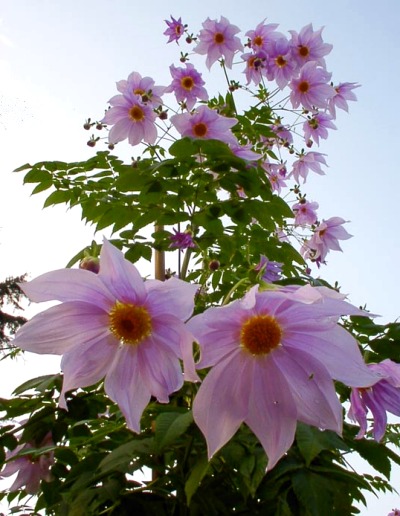Planting the tuber
Your tuber might be sprouting, so please unwrap it carefully. Avoid disturbing the top of the tuber, where the shoots will emerge. Pot size -- You can start your Tree Dahlia tuber in about a 3 gallon pot. After it's grown for 2-3 months, you may transfer it to a 5-10 gallon pot, or into the ground in suitable climates. Soil -- It likes fertile soil
that is well-draining. An example would be a mix of 2 parts quality
potting soil Bury it so the top of the tuber is about 2 inches below the surface. Note that your tuber may have a short piece of last year's stem attached to it, and it's ok if this is exposed. Add water until the soil is light moist throughout, but not fully saturated. Keep it this moist until it sprouts, which could be from 1 to 3 months, depending on when it went dormant. Once it sprouts, give it mostly sunny conditions. Growing onward.. Climate -- Established plants like full sun to a half-day of sun. In hotter climates, some afternoon shade might be appreciated, as well as growing in an oversized pot, to keep the roots cooler. Watering -- The first few months, keep the soil evenly moist (but not constantly soggy). As the plant's root system gets larger, you can let the soil dry out halfway, but avoid letting it get completely dry. If the leaves wilt, water it. Fertilizing -
Most potting soils contain fertilizer, and if yours does, you don't need to feed
the first 3-4 weeks. Then feed about every 2 months during the growing season with a The young shoots are fairly brittle, as are the flower sprays, so protect them from strong winds, or stake them in windy areas. Pruning -- If you don't want a monster-sized plant, or you want to encourage side branches and bushiness, simply prune the top. Flowering -- The plant flowers late in the year, usually in November or December, so frost may destroy the flowers, depending on where you live. Growing it under a tree might provide a few degrees of frost protection. Dormancy -- Around January, after flowering is done, the plants usually drop some or all of their branches. You may cut the remaining branches to the ground after flowering if you wish, or leave them, and new branches will sprout from the tuber. Tubers of mature plants are said to be hardy to 20-25 degrees F (-7 to -4°C) if planted deep and well-mulched, but younger tubers probably aren't as hardy. You can dig the tubers up and move them indoors in a cool spot until March or April. Keep them from drying out, perhaps by storing them in a plastic bag or in a pot in slightly-moist soil. Bugs to watch for -- Spider mites, Aphids, leaf-miners, snails/slugs. Powdery mildew might affect the leaves. Contact me if you have questions. Enjoy your plant! - Jeff Strange Wonderful Things
|
|||||||||


